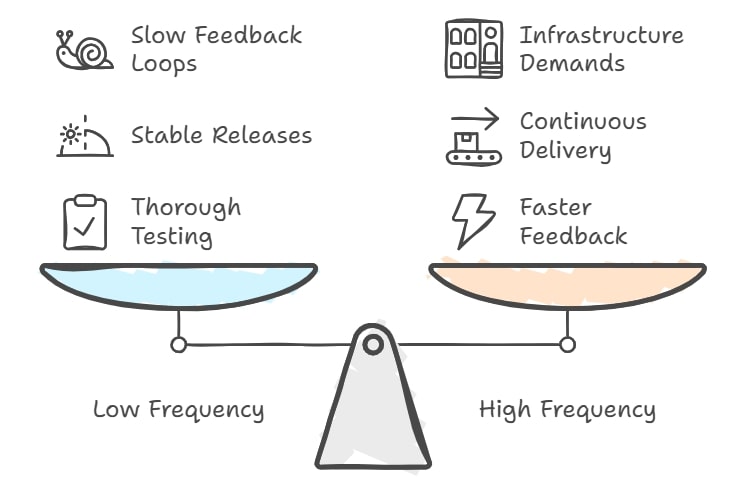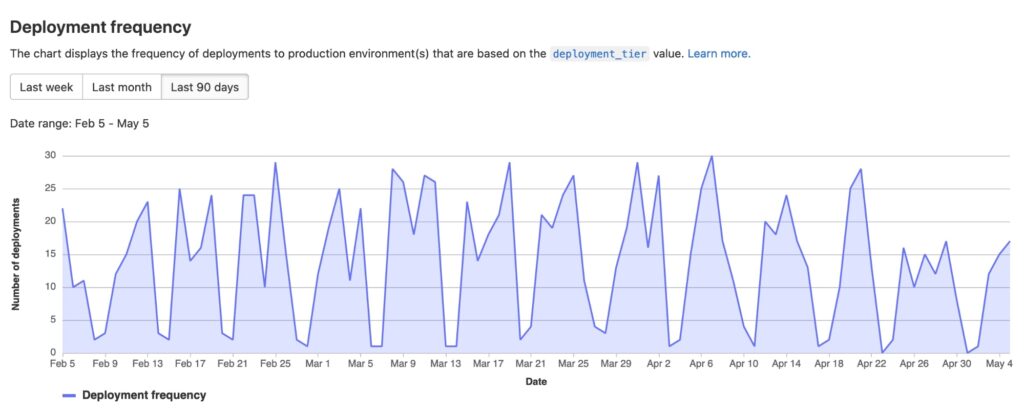Deployment frequency is one of the four primary metrics described by DORA metrics, alongside lead time for changes, MTTR, and change failure rate. Metrics of this nature are vital for improving the software delivery capabilities of an organization.
What is deployment frequency?
Deployment frequency is the number of times code gets deployed to production in a given time frame. It is considered a DevOps and Agile performance metric that indicates how quickly and efficiently the team of developers delivers new functionalities, fixes bugs, or updates to end-users.
The importance of deployment frequency in DevOps
Here are some advantages that high deployment frequency brings to you.
- Faster feedback loops: With frequent deployment, users can provide feedback more quickly, and teams can address it in a timely manner.
- Reduced risk: Smaller changes become easier to test and deploy, lowering the chances of introducing significant bugs and problems into production.
- Improved collaboration: Regular deployments encourage better collaboration among development, operations, and other stakeholders to foster a culture of continuous improvement.
- Enhanced customer satisfaction: With the ability to deliver new features and fixes more quickly, teams can better meet customer needs, improving satisfaction and loyalty.
How to measure deployment frequency
Deployment frequency can be measured by counting the number of successful deployments to production in a given timeframe. Depending on a team’s workflow and infrastructure, various tools and techniques can be used to measure this.
- Automated deployment tools: Most DevOps teams rely on automated deployment tools such as Jenkins, GitLab CI/CD, or CircleCI to manage their deployment pipelines. Often, such tools provide built-in metrics and dashboards for tracking deployment frequency.
- Version control systems: Analyzing data on commits and merging with tools like Git will tell how frequently changes in the code get deployed to production.
- Monitoring and logging: Splunk, ELK Stack, or [Datadog](https://www.datadoghq.com/) will be valid for tracking deployment events illustrating the deployment frequency.
Deployment frequency formula
The deployment frequency formula is very simple:
Deployment Frequency = Number of Deployments / Time PeriodFor instance, if a team deploys code 20 times in a month, their deployment frequency would be:
Deployment Frequency = 20 / 1 = 20 (deployments per month)This formula can be easily adapted to different time frames, such as daily or weekly, depending on the needs and goals of the team.
Spectrum of deployment frequencies

Deployment frequency can typically be differentiated into three layers: low, medium, and high. Each layer has a set of characteristics, advantages, and challenges.
Low deployment frequency
Teams in the low category of deployment frequency deploy code to production less often than once a month. That could be because of longer development cycles, extensive manual testing, or lack of automation.
Benefits:
- Thorough testing: More time for comprehensive testing and quality assurance.
- Stable releases: Fewer releases can mean more stability and fewer user disruptions.
Challenges:
- Slow feedback loops: Delayed user feedback can slow down the improvement process.
- Large changes: Deployments often involve significant changes, increasing the risk of introducing bugs.
Medium deployment frequency
The deployment frequency is medium when deployment to production is done every week or every other week. This is typical for a team that has started their DevOps journey but is still ironing out many kinks.
Benefits:
- Balanced approach: There is a good balance between stability and agility.
- Frequency of updates: Live updates and new features are available to users more often.
Challenges:
- Coordination: Better coordination among team members is required for frequent releases.
- Incremental improvement: Changes are minor and must be carefully managed to avoid problems.
High deployment frequency
High deployment frequency means multiple code deployments to production daily. This practice is common in mature DevOps teams with fully automated CI/CD pipelines.
Benefits:
- Faster feedback: It enables rapid user feedback and rapid adjustments and improvements.
- Continuous delivery: Users receive continuous delivery of new features and fixes.
Challenges:
- Infrastructure demands: This requires more robust and scalable infrastructure to deal with higher frequencies of deployments.
- Quality assurance: With high-frequency changes, quality assurance demands comprehensive automated testing.
Best practices for improving deployment frequency
Technological and cultural changes can help an organization achieve increased deployment frequency. Consider the following best practices:
- Automate testing and deployment: Create a CI/CD pipeline that integrates and deploys automatically on the production environment.
- Adopt microservices architecture: It becomes easier to deploy changes more frequently, with less impact on the whole system, by breaking applications into more minor independent services.
- Implement feature flags: Feature flags allow the deployment of code changes without exposing them immediately to users. It’s a way to have more frequent deployments while reducing risk.
- Foster a DevOps culture: A strong DevOps culture ensures everyone involved in software development, delivery, and maintenance shares responsibility throughout the DevOps life cycle.
- Monitor and analyze metrics: Regularly monitor the deployment frequency and associated metrics to identify bottlenecks and areas for improvement. Use this data to drive continuous improvement initiatives.
Challenges and risks of high deployment frequency
While high deployment frequency is advantageous, teams should also deal with many challenges and risks.
- Quality assurance: With frequent deployments, quality should not be compromised. Testing automation and strong QA processes are a must in maintaining high-quality levels.
- Infrastructure stability: High deployment frequency puts a lot of load on the infrastructure, increasing the chances of downtime. Scalable and resilient infrastructure should be implemented to support high deployment frequency.
- Change management: Frequent changes require appropriate change management processes to keep all the stakeholders informed and prepared for new releases.
Conclusion
Deployment frequency is one of the most important metrics that any DevOps team looking to improve its software delivery processes should consider. It enables a team to decrease feedback cycles, mitigate risk, enhance collaboration, and focus on customer needs. Best practices like automation, microservices architecture, and feature flags improve deployment frequency while responding to challenges and risks associated with the process.

